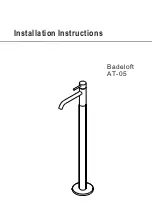
Fitting the MIG welding wire & torch
Risk of crush damage to fingers etc from wire feed rollers & gears, switch machine to
off before touching wire drive mechanism, & keep guard in place.
Always use good quality clean rust free wire.
Firstly check that the size of wire to be used matches the size of groove in the wire feed roller,
if not the roller can be removed & changed around as there are a choice of two grooves in this
roller.
Fit the wire reel onto the spool holder & secure with the red plastic nut, make sure that the
end of the wire is perfectly straight, then push the tension lever to a side & carefully guide the
wire through the guide and into the groove of the roller and push the wire so it appears out at
the front of the machine a few centimeters, place the wire tensioning arm back into position &
set the pressure at around half way on the black pressure device. The welding torch can now
be fitted
to the Euro type fitting
on the front.
The wire spool holder has a tension nut in the middle which can be adjusted to make
sure that the wire spool does not run on at the end of a weld, if the wire is running on
there is a risk of the wire falling off the spool & then not feeding correctly for the next
weld.
Welding return earth
This connects to the socket on the lower right hand side of the front panel. A good welding
earth is essential for correct operation. If your machine is fitted with 2 sockets on the front for
polarity changeover then the one on the right should be used as the welding earth for normal
MIG with gas, & the one on the left for welding earth with gasless wire, with the torch power
lead plugged into the socket which is not being used for the work.
MIG welding basics
The normal process of MIG welding involves an electric arc, a consumable wire and a
shielding gas.
The electrical arc creates the heat which melts both the welding wire and the material being
welded, the result is a weld pool which is protected from the atmosphere by the shielding gas,
or by flux if using a special gas-less wire. Without the shielding gas oxygen, other gases
would contaminate the weld pool to create a weak porous unusable weld.
The welding current used for MIG welding is DC (direct current).
The output characteristics of most MIG welding machines is of the constant voltage type (CV).
Therefore when the voltage has been selected on the machine its value remains fairly
constant, only dropping a little with increasing current draw.
For the vast majority of MIG welding the electrode (wire) is positive potential with the work
being negative.
The main exceptions to this is when using gas-less flux filled wires, the polarity is normally
then changed to negative electrode & positive work.
MIG welding below 250A is normally carried out in dip transfer mode this means that the wire
is constantly dipping into the welding pool & burning back which creates a stable crackle or
buzzing sound if set up correctly.
MIG welding above 250A is done in spray transfer mode, where the wire constantly burns off
into the weld pool without constantly dipping into the pool, this results in a more stable quiet
arc.
Every machine has a certain level of inductance in its output circuit. This inductance greatly
affects the welding performance of the machine when welding in dip transfer mode below
250A. Too high a value would result in a hot unstable arc, too low a value would give rise to
excess splatter and a cold poorly penetrating weld.
The value of inductance on this Oxford machine has been selected to cover the entire welding
range with excellent results.
The welding voltage selection on all models of machines is the main control of the actual heat
input into the welding pool, the higher the volts the more power.
MIG welding voltage range is from 14v to 44v.

























